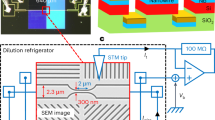
Access this book
Tax calculation will be finalised at checkout
Other ways to access
About this book
The effects discussed in Quantum Dynamics of Submicron Structures include typical quantum interference phenomena, such as the Aharonov-Bohm-like oscillations of the magnetoresistance of thin metallic cylinders and rings, transport through chaotic billiards, and such quantization effects as the integer and fractional quantum Hall effect and the quantization of the conductance of point contacts in integer multiples of the `conductance quantum'. Transport properties and tunnelling processes in various types of normal metal and superconductor tunnelling systems are treated. The statistical properties of the quantum states of electrons in spatially inhomogeneous systems, such as a random, inhomogeneous magnetic field, are investigated. Interacting systems, like the Luttinger liquid or electrons in a quantum dot, are also considered.
Reviews are given of quantum blockade mechanisms for electrons that tunnel through small junctions, like the Coulomb blockade and spin blockade, the influence of dissipative coupling of charge carriers to an environment, and Andreev scattering. Coulomb interactions and quantization effects in transport through quantum dots and in double-well potentials, as well as quantum effects in the motion of vortices, as in the Aharonov-Casher effect, are discussed.
The status of the theory of the metal-insulator and superconductor-insulator phase transitions in ordered and disordered granular systems are reviewed as examples in which such quantum effects are of greatimportance.
Similar content being viewed by others
Keywords
Table of contents (62 chapters)
-
Front Matter
-
Random Magnetic Field
-
Front Matter
-
-
Mesoscopic Fluctuations
-
Front Matter
-
-
Quantum Hall States
-
Front Matter
-
Editors and Affiliations
Bibliographic Information
Book Title: Quantum Dynamics of Submicron Structures
Editors: Hilda A. Cerdeira, Bernhard Kramer, Gerd Schön
Series Title: NATO Science Series E:
DOI: https://doi.org/10.1007/978-94-011-0019-9
Publisher: Springer Dordrecht
-
eBook Packages: Springer Book Archive
Copyright Information: Springer Science+Business Media Dordrecht 1995
Hardcover ISBN: 978-0-7923-3469-9Published: 30 April 1995
Softcover ISBN: 978-94-010-4012-9Published: 14 October 2012
eBook ISBN: 978-94-011-0019-9Published: 06 December 2012
Series ISSN: 0168-132X
Edition Number: 1
Number of Pages: XXIII, 741
Topics: Condensed Matter Physics, Optical and Electronic Materials, Quantum Physics, Solid State Physics, Spectroscopy and Microscopy



